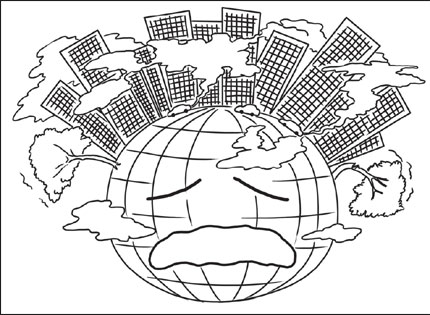
Illustration by Zhou Tao
Gray smog returned to Beijing again over the past few days and forced local residents to wear masks outdoors.
Polluting weather has hit the Chinese capital frequently since the beginning of the year.
A key factor leading to the smog is vehicle exhaust.
About 5.2 million vehicles are running on the roads in the metropolis, which has a population of 20.6 million.
Traffic congestion and shortage of resources, such as water, are also common problems for other large cities in China.
Last Tuesday, delivering a government work report to the first session of the 12th National People's Congress, the Parliament, Premier Wen Jiabao said megacities and large cities should be kept to an appropriate size.
The following day, Zhang Ping, head of the National Development and Reform Commission, said the country should control the expansion of mega and large cities.
China is likely to make a blueprint for the country's urbanization drive in the first half of the year, he added.
By the end of 2012, the country's urbanization level rose to 52.6 percent from 45.9 percent five years ago, marking a historic turning point in the nation's urban-rural population structure. The figure means more than half of the total population live in cities.
In China, a megacity refers to one with a population of 10 million or above and a large city 5 million or more, according to Pan Jiahua, head of the Urban and Environmental Studies Institute at the Chinese Academy of Social Sciences.
Beijing, Shanghai and Chongqing all have a population of more than 20 million. Tianjin, Guangzhou and Shenzhen have a population of more than 10 million.
Authorities believe urbanization offers the largest potential for China to expand domestic demand, which is vital for sustainable growth of the world's second largest economy. The concentration of education, medical care, work opportunities and other resources are major attractions for people who swarm into big cities.
Dense population
However, the excessive density of population will affect the operating efficiency and quality of life, in addition to putting strain on the supply of energy and other resources, said Pan.
The same problems occurred in many other developed countries, like the United States, Japan and Britain during their industrialization, said Wang Ming, a member of the National Committee of the Chinese People's Political Consultative Conference, the country's top political advisory body.
Urban problems China's rapid development has caused urban problems that have become increasingly worrisome, said Wang, adding the country has more than 10 megacities now. In fact, a policy of controlling the scale of large cities, developing appropriately sized, medium cities and actively building small ones was put forward as early as 1980.
But the main tool in the past was the household registration system, or hukou, which ties benefits such as education and medical care, to place of registered residence - not cities where people migrate. The hukou has proved problematic, said Dong Liming, a professor of urban and environment research at Peking University.
Legislation is needed to avoid the concentration of urban facilities and functions, according to Pan.
Large cities should focus on high value-added industries such as high-tech and cultural sectors, whereas small and medium-sized cities and small towns develop their distinctive industries, Pan said.
Beijing, for example, is working hard to accelerate the transformation of its economic growth mode and explore the control of the city's scale and slow population growth, said Beijing Mayor Wang Anshun.
The population of Beijing grew from 16.3 million in early 2008 to 20.6 million currently and is increasing by about 600,000 annually. Beijing covers around 16,800 sq km. Business hub Shanghai, which covers 6,340 sq km, has about 24 million people.
Comprehensive measures should be adopted to control the size of megacities and large cities and new ones should try to avoid the way current megacities have expanded, according to analysts.
"A big population is not necessarily good for a city. What is important is that a city should have its own distinctive features and is livable," said Pan.
According to an urban development report issued by the Chinese Academy of Social Sciences last year, the next five to 10ten years is a key period for China's urbanization drive.
Large cities face challenges in economic structure, planning, construction, management, environment and public services, said the report. It is a must to underline the scientific development of cities and enhance the quality of urbanization, the report said.
By Li Laifang, Wang Xiaojie and Zhao Renwei (Shanghai Daily)
